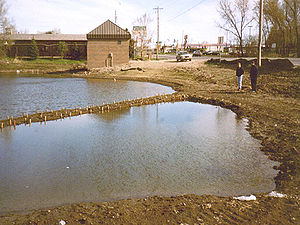
Chemical treatment
Chemical and biological treatment of stormwater enhances settling of suspended sediment by encouraging flocculation. Variations include aluminum sulfate, ferric chloride, chitosan, and polyacrylamide. Chemical and biological treatments are typically used as a final or polishing step in the treatment train.
Contents
Design criteria
Properties of water to be treated (pH, sediment concentration, etc.)
- Level of treatment desired
- Requirements for discharge of treated water to receiving water bodies
- Type of facility required or present
- Pre-treatment or secondary treatment requirements
- Maintenance and monitoring requirements of the system
Benefits
- Quickly removes suspended clays and silts
- Can be used as pre-treatment to remove suspended sediments prior to infiltration
- Can help project meet stringent water clarity and sediment-bound pollutant removal standards
- Suitable for cold climates
Limitations
- Ongoing operation and maintenance of the chemical addition system may be required
- Monitoring may be required to determine the impact on downstream resources
- A pond or sediment collection area is necessary downstream of the treatment site for settling out the flocculants
- May require permit from DNR
- Expensive to build and operate
Description
Chemical and biological agents such as aluminum sulfate, polyacrylamide, ferric chloride, and chitosan can be added to stormwater to encourage the settling of smaller suspended particles. In a typical detention pond, suspended clays and other small particles are not well removed because they require long detention times to settle out. The addition of chemical or biological agents allows the small suspended particles to group together to form a larger conglomerate particle (or flocculent) that rapidly settles out of the water column.
Chemical and biological treatment can be a passive system of flow through a solid form of the media, but it often requires the installation of monitoring and metering devices to ensure that the liquid agent is added at the proper dosage. Chemical or biological treatment can also be used as a temporary or one-time use product for construction or emergency situations.
The MPCA Construction General Permit allows limited use of proprietary devices or “alternative methods”. Use of the alternative method must be approved by the MPCA prior to installation. Approval is limited to those methods that achieve approximately 80 percent removal of total suspended solids. Additionally, the MPCA requires a two-year monitoring plan to measure the actual effectiveness of the method.
Selection
When selecting or specifying a device that utilizes chemical or biological treatment processes, designers should research the following questions.
- What are the minimum or maximum drainage areas recommended for the device or method?
- What are the characteristics of the pollutants in the water used for testing? Review manufacturer’s protocols for testing.
- Are the pollutant removal tests verified by independent organizations such as USEPA, University of New Hampshire, University of Minnesota, Wisconsin Department of Natural Resources, or others?
- Can the chemical or biological treatment agent be discharged into a natural water body?
- What detention time is required for the chemical or biological treatment agent to cause flocculation?
- How often must dosing rates be changed?
- What are the construction costs? Does the cost include all materials, installation, and delivery?
- What are the maintenance requirements? What are the costs of the required maintenance? Is there a standard operation and maintenance plan?
- Will the manufacturer provide design computations and CADD details?
Management suitability
- Water Quality (Vwq) - High
- Channel Protection (Vcp) - Not Applicable
- Overbank Flood Protection (Vp10) - Not Applicable
- Extreme Flood Protection (Vp100) - Not Applicable
- Recharge Volume (VRE) - Not Applicable
Mechanisms
- Infiltration - Not Applicable
- Screening/ Filtration - Not Applicable
- Temperature Control - Not Applicable
- Settling - Applicable
- Evaporation - Not Applicable
- Transpiration - Not Applicable
- Soil Adsorption - Applicable
- Biological/ Micro. Uptake - Applicable
Pollutant removal
- Total Suspended Solids - Applicable a
- Nutrients - Total Phosphorus/Total Nitrogen - Applicable
- Metals - Cadmium, Copper, Lead, and Zinc - Applicable
- Pathogens - Coliform, Streptococci, E. Coli - Not Applicable
- Toxins - Hydrocarbon, Pesticide - Not Applicable
a Target pollutants - actual percentage of pollutant removal varies with each device and installation
This page was last edited on 8 December 2022, at 13:48.
